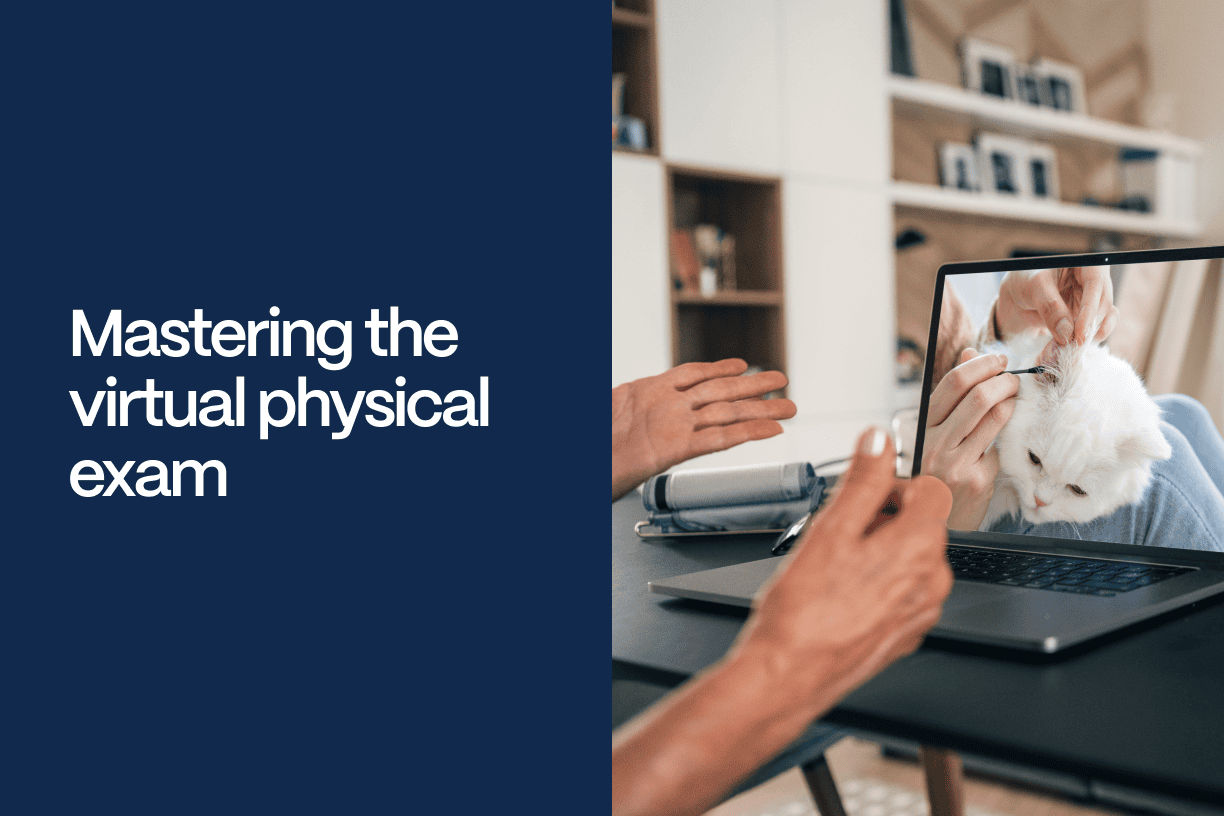Mastering the virtual physical exam

Performing and recording thorough and accurate remote physical assessments is vital for all Vetster vets, whether you’re practicing telemedicine or providing general advice and information. Providing highly skilled remote assessments offers several notable benefits for both veterinarians and pet owners:
- Better patient care with accurate diagnosis and effective treatment recommendations
- Relevant general advice and information that empowers pet owners
- Increased client satisfaction, especially with regard to convenience, accessibility, time savings, and reduced stress
- Improved continuity of care and enhanced collaboration between virtual and in-person veterinary services
While remote assessments have their limitations and cannot replace hands-on examinations, your clients and patients will benefit if you strive to improve your skills in performing them. With a little practice, you’ll be able to utilize virtual patient assessments to leverage technology to expand your reach, improve patient outcomes, and enhance the overall quality of veterinary care.
Even though using video and photos for patient assessments may be new to you, the fundamentals of a good physical exam are the same as in hands-on clinical practice. Let’s take a closer look at the lessons we can learn about patient assessment from in-person practice.
Establish a structured process
“You’ll miss more for not looking than you will for not knowing.” These wise words have echoed in the hallways of veterinary teaching facilities for ages. The best way to make sure you don’t overlook any key elements is to approach your physical assessments the same way and go through the same steps every time. Use prompts or checklists to remind yourself to cover all body systems and include both normal and abnormal findings in your record. When you follow a structured, consistent process that resembles a hands-on exam as closely as possible, you can ensure you're gathering thorough and reliable information about the patient’s status.
Systematically and thoroughly observe and record all the same basics that you would in-clinic to the best of your ability, including at least:
- TPR
- mm/CRT
- Body condition score
- Hydration status
- Is the patient bright, alert, and responsive?
- Movement and coordination
- Coat and skin
- Eyes, ears, nose throat
- Breathing rate and character
- Abdomen soft and non-painful?
The importance of a detailed history
Just like in brick-and-mortar practice, the entire process begins with a detailed history. Ask open-ended questions and allow the client to feel heard, facilitating a two-way exchange of information. Check out this blog post for more tips on how to take a thorough history.
Leverage visual information
Vetster’s video conferencing feature enables you to visually examine pets remotely, evaluating them in the comfort of their own homes To maximize effectiveness, encourage clients to position their devices properly to provide clear, well-lit views of the pet. Utilize Vetster’s in-app noise cancellation and virtual background features to minimize distractions. Even though face-to-face video conferencing is a post-pandemic social norm, let clients know it’s helpful for you if they keep the pet on camera for most of the video appointment. Request that they move the camera as necessary, zoom in, and provide close-up views of areas of concern. Small details are better visualized with photos, so encourage clients to upload these. Throughout the appointment, be attentive to the pet’s behavior, posture, and any visible symptoms to help form a comprehensive assessment.
Actively engage clients
Guide the client in performing specific tasks to assist in the assessment. Let them know what you’re interested in evaluating and how to show it to you. For example, ask them if their pet’s abdomen is soft and non-painful on gentle palpation. Explain how to check gum color and capillary refill so they can accurately report it. This interactive approach empowers clients, enhances their understanding of their pet’s condition, and helps you gather valuable information. The end result is collaborative decision making, enabling you to share relevant information or discuss differential diagnoses and treatment options, depending on your scope of practice. Keep safety in mind at all times, advising clients to proceed with a hands-on physical assessment of their pet only if it is safe to do so.
Proactively avoid common pitfalls
Remote physical assessments are nuanced, but with a little practice you can improve your skills. Common pitfalls include:
- Poor lighting
- Client not keeping pet on camera
- Being rushed or distracted
- Overlooking the little things, like tachypnea
- Difficulty evaluating colors, e.g. gum color
- Difficulty visualizing small findings on video, like teeth, ears, eyes
- Jumping to conclusions and having tunnel vision
- Placing unreasonable expectations on yourself to solve every problem or lower your standard of care
Mitigate these obstacles by planning ahead and being prepared for appointments. Clearly communicate with clients and let them know what you need them to do. Keep an open mind and make objective observations. Diplomatically explain the importance of in-person care. Most importantly, don’t rush. Your time is valuable to clients, so take the time to listen and thoroughly understand the pet and their situation.
Strive for continuous improvement
Striving for continuous improvement is as important with virtual care as it is in hands-on clinical work. Consider yourself as a participant in a lifetime of learning and adaptation as telemedicine guidelines evolve and new technologies emerge. Participate in webinars,conferences, and continuing education opportunities that focus on telemedicine applications. As the field progresses, adapt your practice to incorporate new tools and techniques to enhance your remote physical assessments and overall patient care.
Mastering the virtual physical exam
In an increasingly digital world, telemedicine has emerged as an effective tool for veterinarians to remotely provide virtual care, and Vetster is purpose-built with that in mind. It is a valuable means of assessing patients and delivering vital care. To ensure an accurate understanding of the pet’s status, regardless of if you are diagnosing or staying in the realm of providing general advice, follow best practices for conducting remote physical assessments. With the proper utilization of visual information and active client involvement, you can help ensure the well-being of your virtual patients and support their human companions in managing their pets’ health remotely.
Looking to join Vetster?
You may create an account as a veterinary professional, or learn more here.



